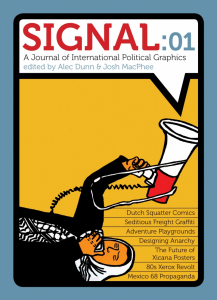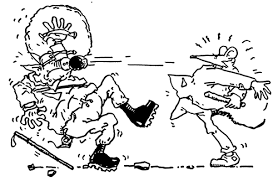
Reviewed by A. Iwasa
The first issue of Signal starts with the words, “SIGNAL is an idea in formation. “It is a response to the myopia of the contemporary political culture in the United States, our blindness to most things beyond our national boundaries, and our lack of historical memory.”
When Signal first landed on my radar, I assumed the editors were just going to phone it in with a well curated, coffee table style art book full of sexy Leftist propaganda images like those from the Spanish Civil War. That written, I was still amped about it but I couldn’t have been more wrong. Since its inception, Signal has been an examination of how the arts play a prominent role in enforcing the status quo, though also serving a similar role as part of social change movements attempting to undermine the way things are. It’s exactly the sort of material I was practically dying for in 1999 as I pivoted the focus of my creative work from making music and writing lyrics to do doing ‘zines.
I’ve found a great deal of the material printed on questions about the role of the arts in social change movements to be lacking for the most part. But folks with Signal hit the ground running, by framing some of these questions in larger contexts, such as in this issue by interviewing a Xicana print making project’s three members, the Taller Tupac Amaru collective, interspersing their artwork with photographs.
“I think about it in terms of evaluation. I’ve been asking, ‘Is my work really making an impact?’ And then I’ve been taking a couple of steps back and wondering if I’m even asking the right questions,” said Melanie Cervantes, a member of the Taller Tupac Amaru collective as their conversation moved from arts education, work under capitalism, social movements both mass and highly localized, and much more.
This was followed by an interview with a long time Dutch punk vocalist and comic artist, Johannes van de Weert.

Afterwards is a photo essay of freight train graffiti, something I’ve long enjoyed as the merger of two of my favorite things. It’s all art by IMPEACH from the crew ALB, that took its name from the Communist Party’s Abraham Lincoln Brigade who fought the fascists in Spain during their civil war. This is actually the second time the Spanish Civil War has come up in the text: Johannes van de Weert did a comic called No Pasaran about Dutch anti-Fascist volunteers who fought in the war.
The following interview adds to Signal’s internationalism, but also even further depth by bringing in a veteran of the 1968 Mexican Student Movement, Felipe Hernandez Moreno, a printmaker who had been involved with Grupo 65. The interview is heavy for a number of reasons, but I think perhaps most important are his descriptions of Grupo 65’s organizational forms as they produced posters that were illegal, and put themselves at tremendous risk posting and distributing them, themselves. It’s not hard to imagine a future US where this sort of information will be invaluable. Here I can’t emphasize enough, all of the interviews and articles are interspersed with top notch visual art and/or photographs. It’s sharply laid out and engaging.
Next is an essay about adventure playgrounds, child built playgrounds that emerged in Copenhagen during the German occupation of World War II, with the Emdrup playground started by the Copenhagen Workers’ Co-operative Housing Association. The essay compares and contrasts how children relate to the formal settings of conventional playgrounds vs. the DIY aspects of adventure playgrounds.
This issue closes with an interview with the primary cover artist of Anarchy: A Journal of Anarchist Ideas, Rufus Segar. The journal went from 1961-’70, so as you can imagine, Segar has some good stories about working in the era’s art industry, volunteering for the journal on the side, printing, and the creative process in general.
When PM Press sent me the complete run of Signal, I originally thought I’d review #8 standing alone since it was new, and try to do an overarching deep dive about the first seven. But these journals are too good and need individual attention.
They can be ordered here from PM Press.
